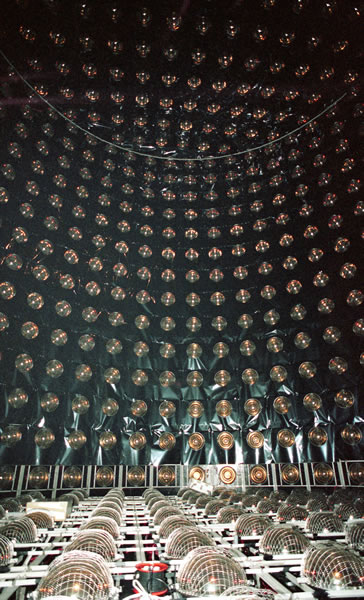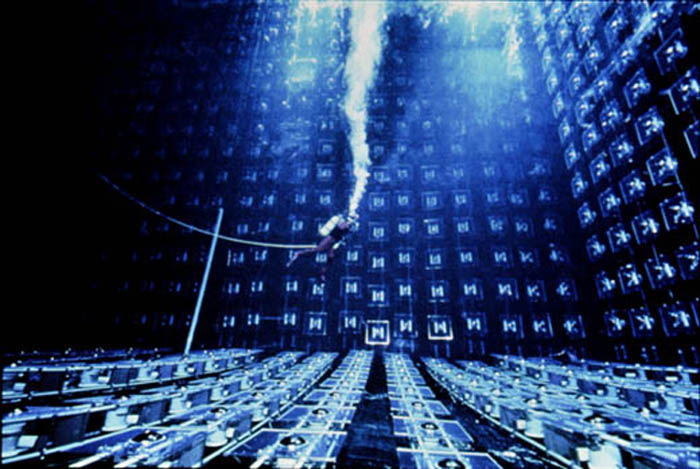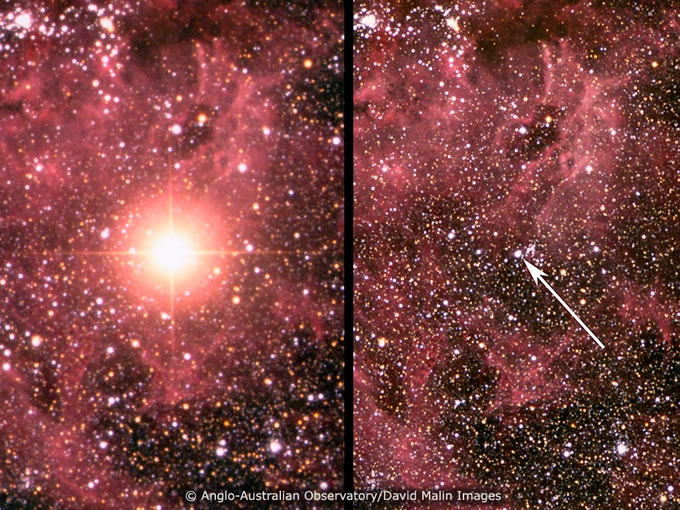At the beginning of the 80’s, big underground detectors were built to search for proton decay, following the predictions of the grand unified theories. No decay has been observed, but, on the 23th of February 1987, two experiments, Kamiokande in Japan and IMB in USA, detected an unexpected signal. During a few seconds, they received a burst of neutrinos having a mean energy of ~10-20 MeV.


It has been associated to the optical observation of SN1987A, a type-II supernova that exploded in the Large Magellanic Cloud, ~150000 years ago [Wik]. The signal (10 events in Kamiokande [Hir87], 8 in IMB [Bio87] and 5 in Baksan [Ale88]) has been interpreted as antineutrino interactions on protons (inverse beta decay).
This was the proof that supernovae emit a huge quantity of neutrinos which take out 99% of the energy of this cosmic explosion. The models describing the core collapse of a supernova show that approximately 3×1053ergs of gravitational binding energy are released in a burst consisting of ~1058 neutrinos in a time interval of a few seconds.
In 1941, Gamow had already anticipated such event [Gam41]: “at the very high temperatures and densities which must exist in the interior of contracting stars during the later stages of their evolution, one must expect a special type of nuclear processes accompanied by the emission of a large number of neutrinos…”.
Core-collapse models have been developed for supernovas (see for example [Bro88,Bet90,Bur90]) and it has been soon supposed that neutrinos could play an active role in the supernova explosion [Lev74]. 3-dimensional models with neutrino-driven explosions have recently made significant progresses [Jan18].
| The SN1987A event was the first direct observation in neutrino astronomy. In 2018, we are still eagerly waiting for a new type-II supernova event ! |
Further information
The online Symmetry Magazine published in February 2006 an article on the Supernova SN1987A.
During the conference on the History of the Neutrino (Sept. 5-7, 2018 in Paris) the history of Supernova neutrinos was reviewed by A. Burrows (Princeton University, USA) : here the slides , the video of his talk and his contribution to the Proceedings.
References
| Author(s) | Title | Reference | Key-words | |
|---|---|---|---|---|
| Agl87 | M. Aglietta et al. | On the event observed in the Mont Blanc underground laboratory during the occurrence of supernova 1987A | Europhys. Lett. 3 (1987) 1315 and Europhys. Lett. 3 (1987) 1321 | historical supernova milestonebib supernbib |
| Ale88 | E.N. Alexeyev, L.N. Alexeyeva, I.V. Krivosheina, V.I. Volchenko | Detection of the neutrino signal from SN1987A in the LMC using the Baksan underground scintillation telescope | Phys. Lett. B 205 (1988) 209 | historical supernova supernbib |
| Arn67 | D. Arnett | Mass dependence in gravitational collapse of stellar cores | Canadian Journal of Physics 45 (1967) 1621 | supernova supernbib |
| Bet90 | H.A. Bethe | Supernova mechanisms | Rev. Mod. Phys. 62 (1990) 801 | review rmp supernova supernbib |
| Bio87 | R.M. Bionta et al., IMB collaboration | Observation of a neutrino burst in coincidence with supernova SN1987A in the Large Magellanic Cloud | Phys. Rev. Lett. 58 (1987) 1494 | historical supernova milestonebib overviewbib supernbib plotbib |
| Bro88 | G.E. Brown ed. | Theory of supernovae | Physics Reports 163 (1988) 1 - including : J. Cooperstein / Neutrino in supernovae / p. 95 // E.S. Myra / Neutrino transport in stellar collapse / p. 127 // F. Reines and J. VanderVelde / Observation on SN1987A by neutrino light / p. 137 | review physrep supernova supernbib |
| Bru85 | S.W. Bruenn | Stellar core collapse - Numerical model and infall epoch | Astrophysical Journal Suppl. Ser. 58 (1985) 771 | supernova supernbib |
| Bur86 | A. Burrows and J.M. Lattimer | The birth of neutron stars | Astrophysical Journal 307 (1986) 178 | supernova supernbib |
| Bur90 | A. Burrows | Neutrinos from supernova explosions | Ann. Rev. Nucl. Part. Sci. 40 (1990) 181 | review annualrev supernova supernbib |
| Chi61 | H.Y. Chiu | Annihilation process of neutrino production in stars | Phys. Rev. 123 (1961) 1040 | supernova supernbib |
| Chi64 | H. Y. Chiu | Supernovae, neutrinos and neutron stars | Annals of Physics 26 (1964) 364 | supernova supernbib |
| Col66 | S.A. Colgate and R.H. White | The hydrodynamic behaviour of supernovae explosions | Astrophysical Journal 143 (1966) 626 | supernova supernbib |
| Gam41 | G. Gamow and M. Schoenberg | Neutrino theory of stellar collapse | Phys. Rev. 59 (1941) 539 | historical supernova milestonebib overviewbib supernbib |
| Hir87 | K.S. Hirata et al., Kamiokande collaboration | Observation of a neutrino burst from the supernova SN1987A | Phys. Rev. Lett. 58 (1987) 1490 | historical supernova milestonebib overviewbib supernbib plotbib |
| Jan18 | H.T. Janka | Neutrino-driven explosions in 3D supernova explosions | Neutrino 2018, Heidelberg | supernova supernbib |
| Lev74 | Barbara G. Levi | Neutrino interactions may explain supernova explosions | Physics Today 27, 6, 17 (1974) | outreach supernova supernbib |
| Maz74 | T.J. Mazurek | Degeneracy effects of neutrino mass ejection in supernovae | Nature 252 (1974) 287 | supernova supernbib |
| Ruj87 | A. de Rujula | May a supernova bang twice ? | Phys. Lett. 193 (1987) 514 | supernova supernbib |
| Sat75 | K. Sato | Supernova explosion and neutral currents of weak interaction | Prog. of Theor. Phys. 54 (1975) 1325 | supernova supernbib |
| Var19 | D. Vartanyan, A. Burrows, D. Radice, M.A. Skinner and J. Dolenc | A successful 3D core-collapse supernova explosion model | Mon. Not. Royal Astron. Soc. 482 (2019) 351 | supernova supernbib |

